rims AUDI A3 2012 Owner´s Manual
[x] Cancel search | Manufacturer: AUDI, Model Year: 2012, Model line: A3, Model: AUDI A3 2012Pages: 280, PDF Size: 70.11 MB
Page 77 of 280
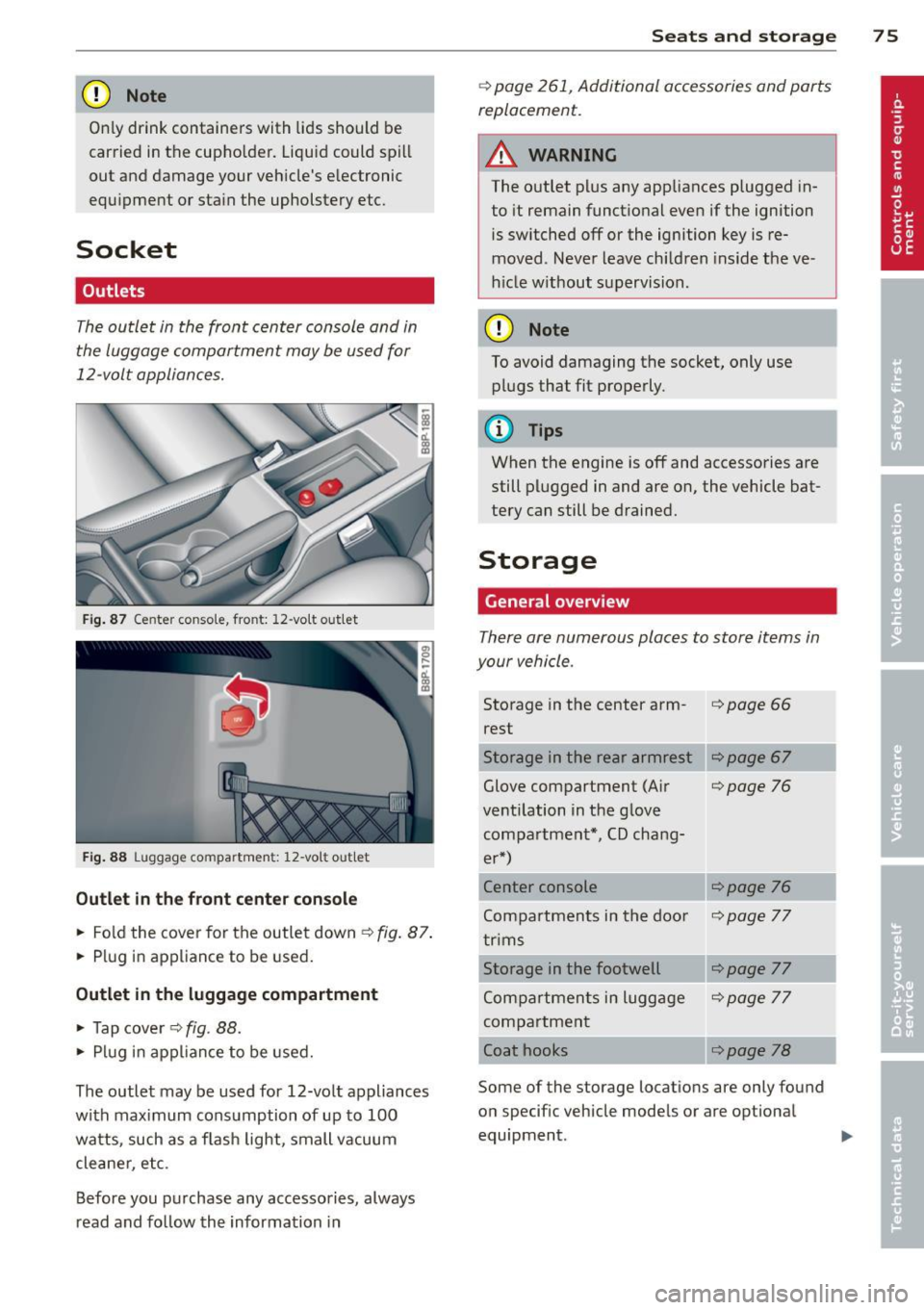
CD Note
Only drink containers with lids should be
carried in the cupho lder. Liqu id could spill
out and damage your veh icle's e lectronic
equ ipment or sta in the upholstery etc.
Socket
Outlets
The outlet in the front center console and in
the luggage compartment may be used for
12-volt appliances.
Fig. 87 Ce nter conso le, front: 12-vo lt out let
Fig. 88 L uggage compartmen t: 12-vo lt out let
Outlet in the front center console
.. Fold the cover for the outlet down ¢ fig. 87.
.. Plug in appliance to be used.
Outlet in the luggage compartment
.. Tap cover ¢ fig. 88.
.. Plug in appliance to be used.
The outlet may be used for 12-volt appliances
with maximum consumption of up to 100
watts, such as a f lash light, small vacuum
cleane r, etc.
Before you purchase any accessories, always
read and follow the information in
Seats and storage 75
¢ page 261, Additional accessories and parts
replacement.
A WARNING
The outlet plus any appliances plugged in
to it remain functional even if the ignition
is switched off or the ignition key is re
moved. Never leave children inside the ve
h icle w ithout supervision.
CD Note
To avoid damaging the socket, only use
plugs that fit properly.
(y Tips
When the engine is off and accessories are
still plugged in and are on, the vehicle bat
tery can still be drained.
Storage
General overview
There are numerous places to store items in
your vehicle .
Storage in the center arm-i=>page 66
rest
Storage in the rear armrest
Glove compartment (Air
¢page 76
ventilation in the glove compartment*, CD chang-
er*)
Center console
¢page 76
Compartments in the doo r ¢page 77
trims
Storage in the footwell
¢page 77
Compartments in luggage ¢page 77
compartment
Coat hooks
¢page 78
Some of the storage locations are only found
on specif ic vehicle models or are optional
equipment .
Page 79 of 280
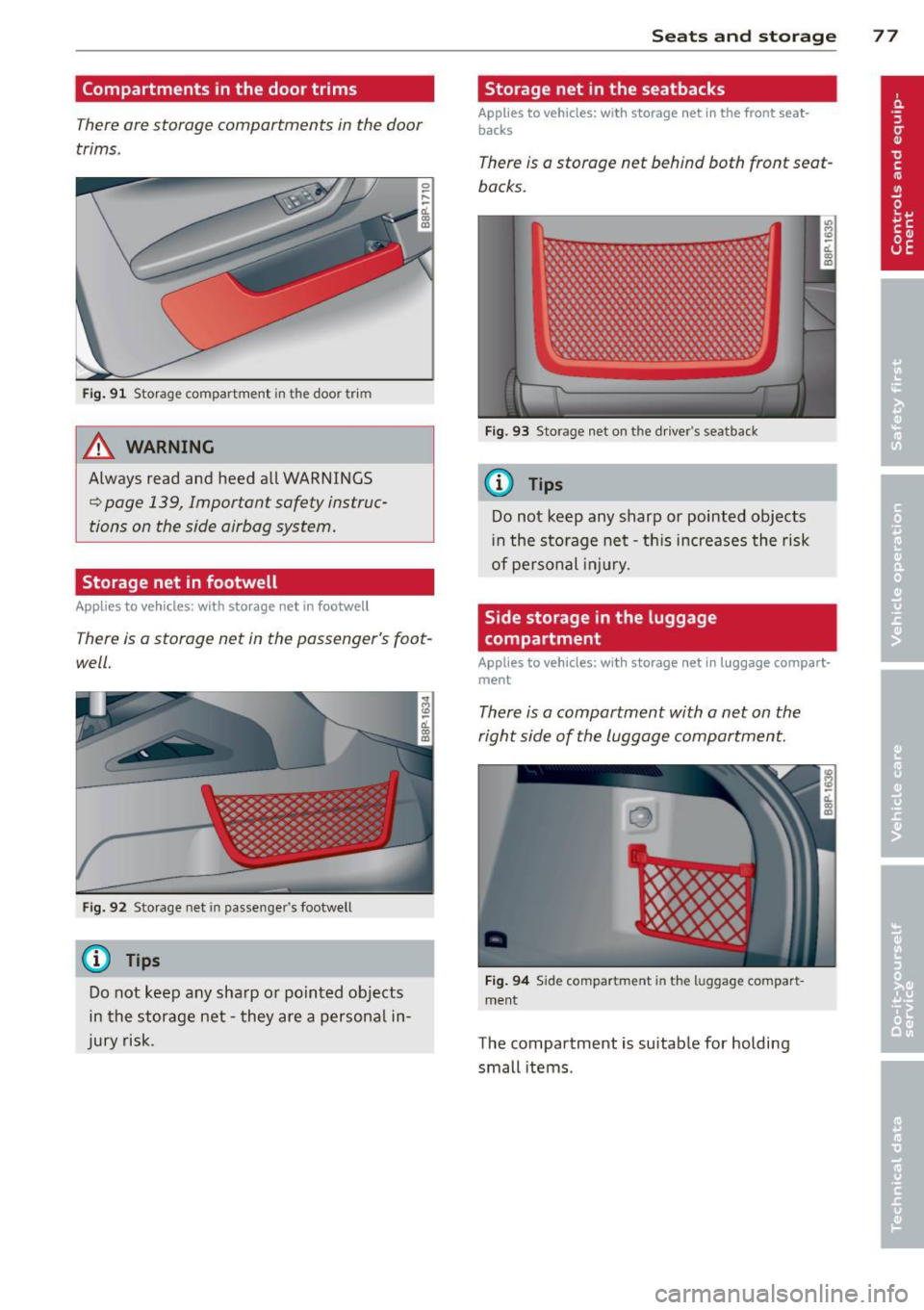
Compartments in the door trims
There are storage compartments in the door
trims .
Fig. 91 Storage compartment in the door trim
A WARNING
Always read and heed all WARNINGS
c:::> page 139, Important safety instruc
tions on the side airbag system.
Storage net in footwell
Applies to vehicles: with storage net in footwell
There Is a storage net in the passenger's foot
well.
Fig. 92 Storage net in passenger's footwell
(D Tips
Do not keep any sharp or pointed objects
in the storage net -they are a persona l in
jury risk.
S ea ts a nd s to rage 77
Storage net in the seatbacks
Applies to vehicles: wit h storage net in the front seat
backs
There is a storage net behind both front seat
backs.
Fig. 93 Storage net on th e d river's seatback
(D Tips
Do not keep any sharp or pointed objects
i n the storage net -th is increases the risk
of pe rsonal injury.
Side storage in the luggage
compartment
Applies to vehicles: wit h storage net in luggage compart
ment
There is a compartment with a net on the
right side of the luggage compartment.
Fig . 9 4 Side compartment in the luggage compart
ment
The compartment is suitable for holding
small items .
Page 184 of 280
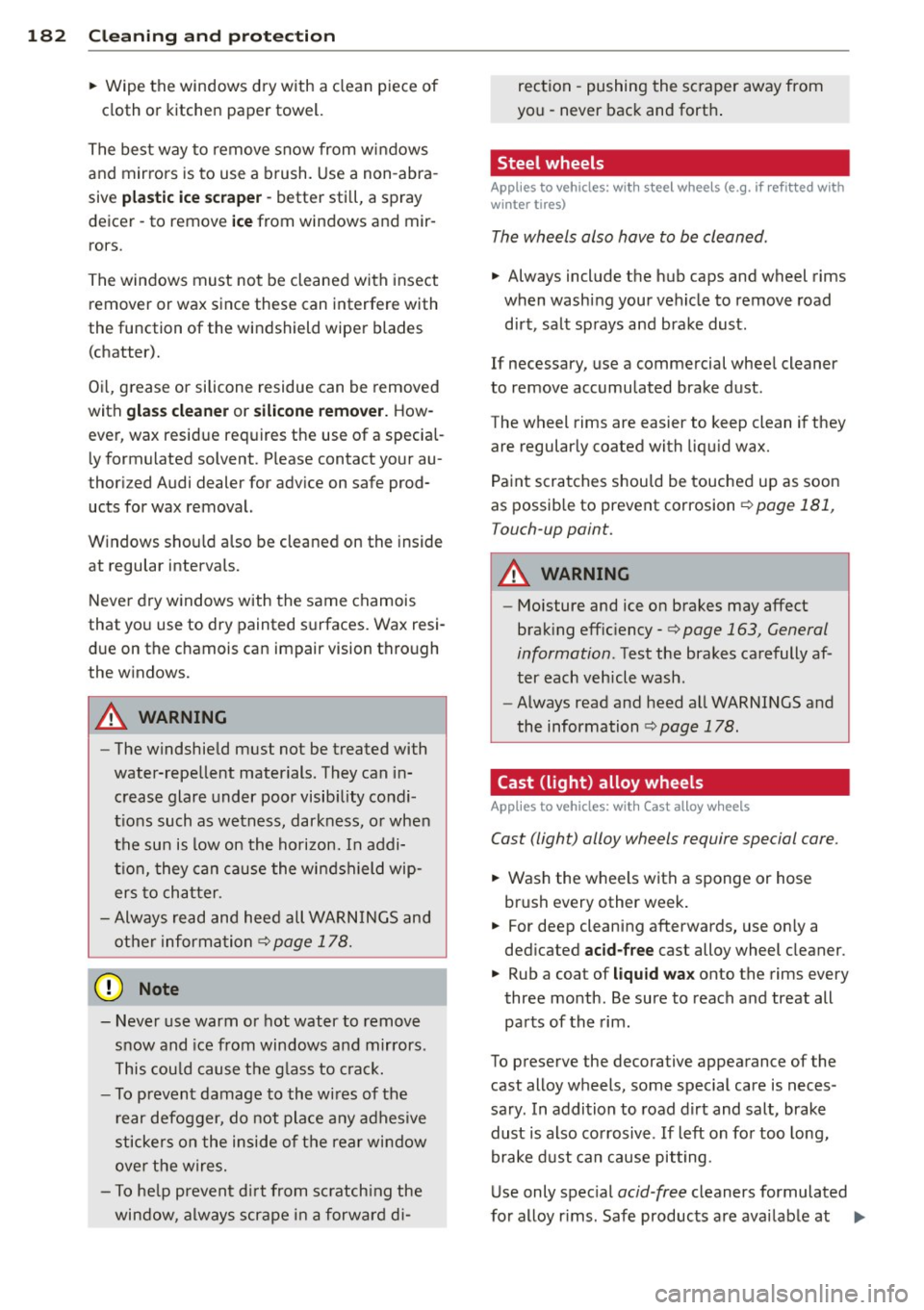
182 Cleaning and protection
• Wipe the windows dry with a clean piece of
cloth or kitchen paper towel.
The best way to remove snow from w indows
and mir rors is to use a brush. Use a non -abra
sive
pla stic ice scraper -better still, a spray
deicer -to remove
ic e from windows and mir
rors.
The windows must not be cleaned with insect remover or wax since these can interfere with
the function of the windshield wiper blades (chatter).
O il, grease or silicone residue can be removed
with
glass cle aner or silicone remo ver. How
ever, wax residue req uires the use of a specia l
ly form ulated solvent. P lease contact your au
thor ized Audi dealer for adv ice on safe prod
ucts for wax removal.
Windows sho uld a lso be cleaned on the inside
at regular interva ls.
Never dry windows with the same chamois
that you use to dry painted s urfaces. Wax resi
due on the chamois can impair vision thro ugh
the windows.
A WARNING
- The windshie ld m ust not be treated with
water-repellent materials. They can i n
c rease glare under poor visib ility condi
t ions such as wetness, darkness, o r whe n
the sun is low on the hori zon. In addi
t io n, they ca n cause the wi ndshield wip
ers to chatter .
- Always read and heed all WARN INGS and
othe r inform ation
Qpage 178.
0 Note
- Never use warm or hot water to remove
s now and ice from windows a nd mirrors.
This cou ld cause the g lass to c ra ck .
- To prevent damage to the wi res of the
r ear defogger, do not place any adhesive
sticke rs o n the inside of t he rear w indow
ove r the wires.
- To he lp prevent d irt from s cratch ing the
window, always scrape i n a forwar d di- rec
tion -pushing the sc raper away from
you -never bac k and fort h.
Steel wheels
Applies to vehicles: with steel wheels (e .g. if refitted with
winter tires)
The wheels also have to be cleaned.
• Always include the hub caps and wheel rims
when wash ing your vehicle to remove road
dirt, sa lt sprays and brake dust .
If necessary, use a commercial whee l cleaner
to remove accumulated brake dust.
The wheel rims are easier to keep clean i f they
are regularly coated with liq uid wax.
Paint scra tches shou ld be touched up as soon
as possib le to prevent corrosion
¢ page 181,
Touch-up paint.
A WARNING .....__
- Moisture and ice on brakes may affect
brak ing eff ic iency-
q page 163, General
information . Test the brakes ca refully af
ter each vehicle wash .
- Always read a nd heed a ll WARNINGS and
the information
q page 178.
Cast (light) alloy wheels
Applies to vehicles : with Cast alloy wheels
-
Cast (light) alloy wheels require special care.
• Wash the w heels with a sponge or hose
brush every other week .
• For deep cleaning afterwards, use on ly a
ded icated acid-free cast alloy wheel cleaner.
• Rub a coat of
liquid wa x onto the rims every
three month. Be sure to reach and treat all
parts of the rim .
To preserve the decorative appearance of the cast alloy w heels, some special care is neces
sary. In addition to road dirt and salt, brake dust is also co rrosive . If left on fo r too long,
brake d ust can cause pitting.
U se only spec ial
acid -free cleaners formulated
fo r alloy r ims . Safe products are ava ilab le at ..,_
Page 185 of 280
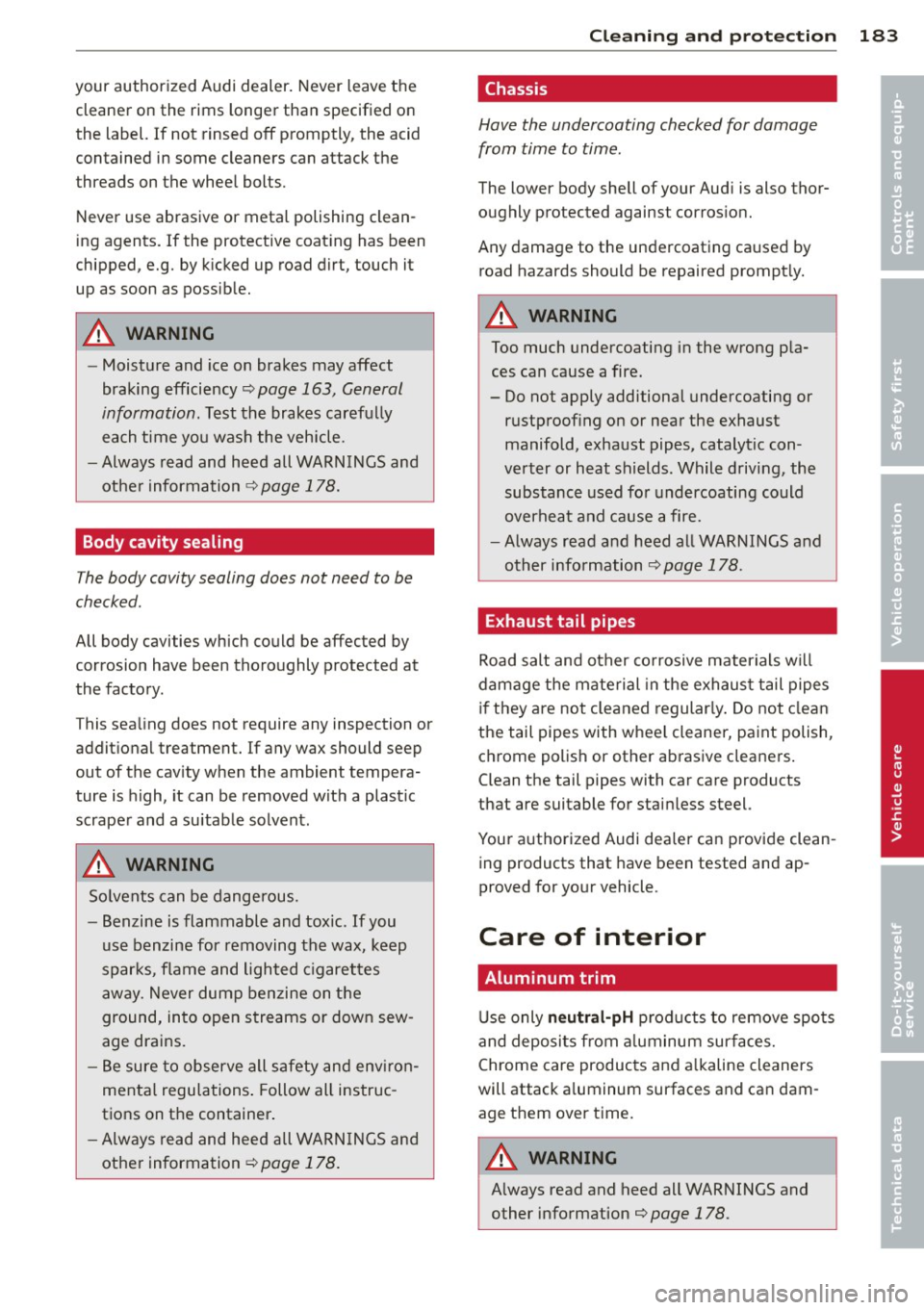
your authorized Audi dealer. Never leave the cleaner on the rims longer than specified on
the label. If not rinsed
off promptly, the acid
contained in some cleaners can attack the
threads on the wheel bolts.
Never use abrasive or meta l polishing clean
ing agents.
If the protective coat ing has been
chipped, e.g. by kicked up road dirt, touch it
up as soon as possible.
A WARNING
-Moisture and ice on brakes may affect
braking efficiency~
page 163, General
information.
Test the brakes carefully
each time you wash the vehicle.
- Always read and heed all WARNINGS and
other information¢
page 178.
Body cavity sealing
-
The body cavity sealing does not need to be
checked.
All body cavities which could be affected by
corrosion have been thoroughly protected at
the factory.
This sea ling does not require any inspection or
addit ional treatment. If any wax should seep
out of the cavity when the ambient tempera
ture is high, it can be removed with a plast ic
scrape r and a suitab le solvent .
A WARNING
Solvents can be dangerous.
- Benzine is flammable and toxic. If you
use benzine for removing the wax, keep
spar ks, flame and lighted cigarettes
aw ay. Never dump benzine on the
ground, in to open streams or down sew
age drains.
- B e sure to observe all safety and env iro n
menta l regulations . Follow all instruc
tions on t he container .
- Always read and heed all WARN INGS and
other informa tion¢
page 178 .
Cleaning and protec tion 183
Chassis
Hove the undercoating checked for damage
from time to time.
The lower body shell of your Aud i is also thor
oughly protected against corrosio n.
Any damage to the undercoating ca used by
road hazards should be repaired prompt ly.
A WARNING
Too much undercoating in the wrong p la
ces can cause a fire.
- Do not apply additional undercoating or
rustproof ing on or near the exhaust
manifold, exhaust pipes, catalytic con
verter or heat shields. While driving, the
substance used fo r undercoating could
overhea t and cause a fire.
- Always read and heed all WARNINGS and
other info rmation
¢ page 178.
Exhaust tail pipes
Road salt and o ther co rrosive materials w ill
damage the material in the exhaus t tail pipes
i f they are not cleaned regular ly . Do not clean
the tail pipes with whee l cleaner, pa int polish,
c h rome polish or other abrasive clea ners .
Clean the tail pipes with car care products
that are suitable for stainless steel.
Your authorized Audi dea ler can provide clean
ing products that have been tested and ap
proved for your vehicle.
Care of interior
Aluminum trim
Use only neutral-pH products to remove spots
and deposits from a luminum sur faces.
Chrome care products and a lkaline cleaners
will attack a luminum surfaces and can dam
age them over time.
A WARNING
-Always read and heed all WARNINGS and
other information
¢ page 178.
•
•
Page 214 of 280
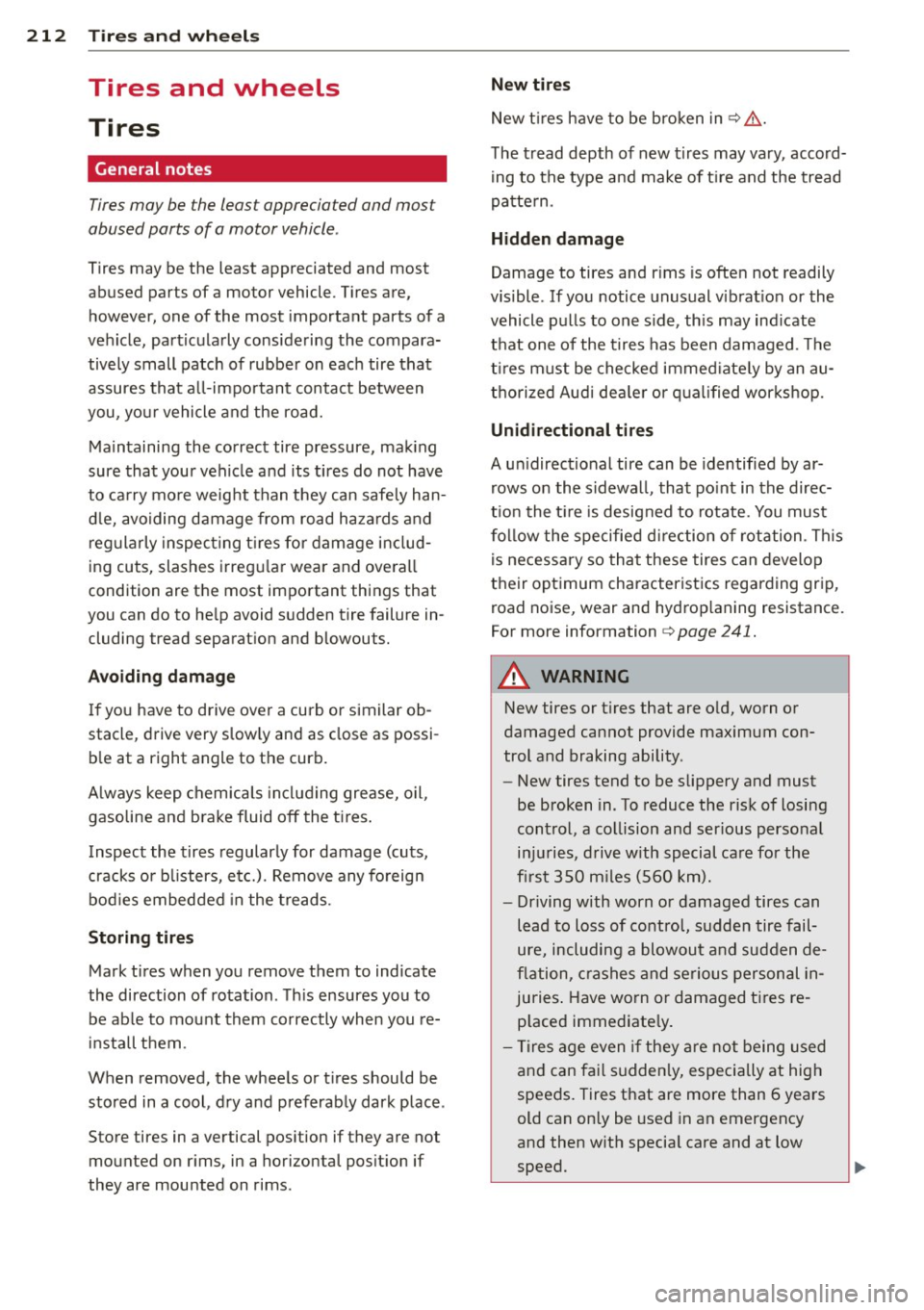
212 Tire s and wheel s
Tires and wheels
Tires
General notes
Tires may be the least appreciated and most
abused parts of a motor vehicle .
Tires may be the least appreciated and most
abused parts of a motor vehicle . Tires are,
however, one of the most important parts of a
vehicle, particularly considering the compara
tive ly small patch of rubber on each tire that
assures that a ll-impo rtant contact between
you, your vehicle and the road.
Maintaining the correct tire pressure, mak ing
sure that your vehicle and its tires do not have
to carry mo re weight than they can safe ly han
d le, avoiding damage from road hazards and
reg ularly inspecting t ires for damage includ
ing cuts, slashes irregu la r wear and ove rall
condition are the most important things that
you can do to he lp avoid sudden tire failure in
cluding tread separation and blowouts.
Avoiding damage I f you have to drive over a curb or similar ob
stacle, drive very s low ly and as close as possi
b le at a right angle to the curb.
A lways keep chem ica ls includ ing gre ase, o il,
gasoline and b rake fluid off the ti res .
Inspect the t ires regularly for damage (cuts,
cracks or b listers, etc.). Remove any fo reign
bod ies embedded in the treads.
Storing tires Mark tires when you remove them to indicate
the direction of rotation . Th is ensures you to
be ab le to mount them correctly when you re
install t hem.
When removed, the whee ls or t ires should be
stored in a cool, d ry and preferably dark place .
Store tires in a vertical pos ition if they are not
mounted on rims, in a horizontal pos it ion if
they are mounted on rims. New tire
s
New t ires have to be broken in¢&,. .
T he tread depth of new t ires may vary, accord
ing to the type a nd make of t ire and the tread
pa tte rn .
Hidden damage
Damage to tires and r ims is ofte n not readily
vis ible . If you notice unusual v ibrat ion or the
vehicle p ulls to one side, th is may ind icate
t h at one of the t ires has been damaged . Th e
t ir es m ust be checked immed iate ly by an au
tho rized Aud i dea le r or q uali fied wor ks hop.
Unidirectional t ires
A un idirectional tire can be identified by ar
rows on the sid ewa ll, that po int in the direc
t ion the t ire is desig ned to rotate. You mus t
f ol low the specified d irection of rotation . This
is necessary so that these tires can develop
their optimum characterist ics regarding grip,
road no ise, wear and hyd rop laning resistance.
For more information ¢
page 241.
A WARNING
-New tires or tires that are old, worn or
damaged cannot provide maximum con
trol and braking ability .
-
-New tires tend to be slippery and must
be broken in . To reduce the risk of losing
control, a co llision and ser ious personal
in jur ies, d rive w ith special ca re fo r the
fi rst 350 m iles (560 km).
- Driving with worn or damaged tires can
le ad to loss of control, sudden tire fail
ure, including a blowou t and sudden de
fl ation, c rashes and seriou s personal in
juries . Have wo rn or damaged t ires re
p laced immediate ly .
- T ires age even if they are not being used
an d can fai l sudden ly, especially at high
speeds. Tires that are more than 6 years
old can only be used in an emergency
and then w ith specia l care and at low
speed.
Page 220 of 280
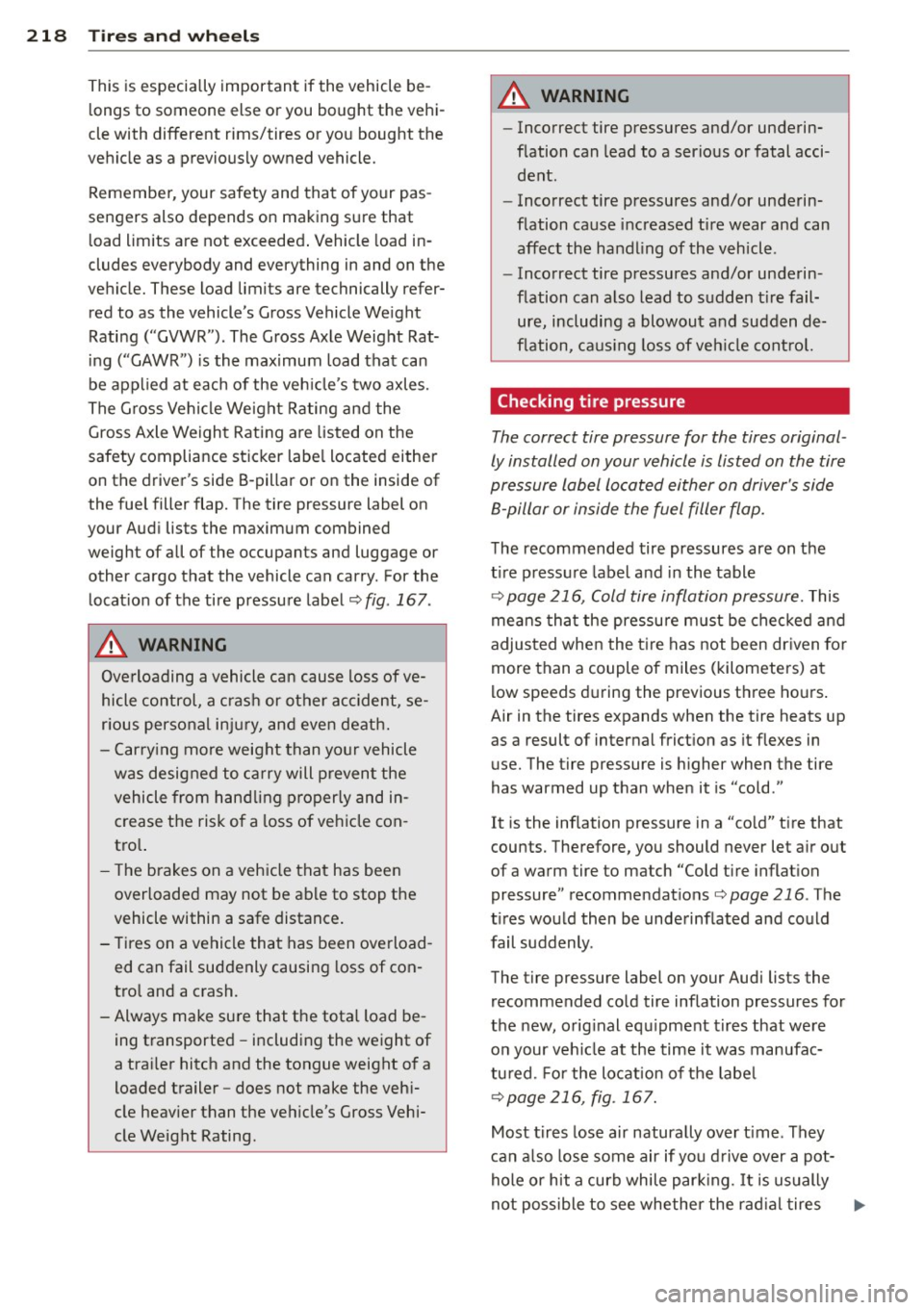
218 Tires and wheels
This is especia lly important if the vehicle be
longs to someone else or you bought the vehi
cle with different rims/tires or you bought the
vehicle as a previously owned vehicle.
Remember, your safety and that of your pas
sengers also depends on making sure that
load limits are not exceeded. Vehicle load in
cludes everybody and everything in and on the
vehicle. These load limits are technically refer
red to as the vehicle's Gross Vehicle Weight
Rating (' 'GVWR"). The Gross Axle Weight Rat
ing ("GAWR") is the maximum load that can
be applied at each of the vehicle's two axles.
The Gross Vehicle Weight Rating and the
Gross Axle Weight Rating are listed on the
safety compliance sticker label located either
on the driver's side B-pillar or on the inside of
the fuel filler flap. The tire pressure label on
your Audi lists the maximum combined
weight of all of the occupants and luggage or
other cargo that the vehicle can carry. For the
location of the tire pressure label
o fig. 167.
_& WARNING
Overloading a vehicle can cause loss of ve
hicle control, a crash or other accident, se
rious personal injury, and even death.
- Carrying more weight than your vehicle
was designed to carry will prevent the
vehicle from handling properly and in
crease the risk of a loss of vehicle con
trol.
- The brakes on a vehicle that has been
overloaded may not be able to stop the
vehicle within a safe distance.
- Tires on a vehicle that has been overload
ed can fail suddenly causing loss of con
trol and a crash.
- Always make sure that the total load be
ing transported -including the weight of
a trailer hitch and the tongue weight of a
loaded trailer -does not make the vehi
cle heavier than the vehicle's Gross Vehi
cle Weight Rating.
A WARNING
- Incorrect tire pressures and/or underin
flation can lead to a serious or fatal acci
dent.
- Incorrect tire pressures and/or underin
flation cause increased tire wear and can affect the handling of the vehicle.
- Incorrect tire pressures and/or underin
flation can also lead to sudden tire fail
ure, including a blowout and sudden de
flation, causing loss of vehicle control.
Checking tire pressure
The correct tire pressure for the tires original
ly installed on your vehicle is listed on the tire
pressure label located either on driver's side 8-pillar or inside the fuel filler flap.
The recommended tire pressures are on the
tire pressure label and in the table
o page 216, Cold tire inflation pressure. This
means that the pressure must be checked and
adjusted when the tire has not been driven for
more than a couple of miles (kilometers) at
low speeds during the previous three hours.
Air in the tires expands when the tire heats up
as a result of internal friction as it flexes in
use. The tire pressure is highe r when the tire
has warmed up than when it is "cold ."
It is the inflation pressure in a "cold" tire that
counts. Therefore, you should never let air out
of a warm tire to match "Cold tire inflation
pressure" recommendations
o page 216. The
tires would then be underinflated and could
fail suddenly.
The tire pressure label on your Audi lists the
recommended cold tire inflation pressures for
the new, original equipment tires that were
on your vehicle at the time it was manufac
tured. For the location of the label
opage 216, fig. 167.
Most tires lose air naturally over time . They
can also lose some air if you drive over a pot
hole or hit a curb while parking. It is usually
not possible to see whether the radial tires ..,.
Page 225 of 280

unbalanced, resulting in vib rations you can
usually feel through the steering wheel.
Unba lanced wheels mus t be rebalanced to
avoid excessive wea r on s teer ing, suspens ion
and tires. A wheel must a lso be rebalanced
when a new tire is installed.
Incorrect wheel alignment
Inco rrect whee l alignment can cause exces
sive tire wea r, impair ing t he safety of the veh i
cle. If t ires show excess ive wear, have the
wheel alignment checked by an authorized
Audi dealer or qualified workshop.
All Wheel Drive
Ve hicles w it h quattro ® must always have t ires
of the same s ize, construction and tread type.
F or details see
¢ pag e 166 .
A WARNING
Sudden tire failure can lead to loss of con
tro l, a crash and serious persona l injury!
- Never drive a veh icle when the tread on
any t ire is worn down to the wear indica
tors.
- Worn tires are a safety hazard , they do
not grip well on wet roads and increase
your risk of"hydrop lan ing" and loss of
co ntrol.
- Always keep chemicals that can cause
tire damage, such as grease, oil, gasoline
and brake fluid away from tires.
- Tires age even if they are not being used
and can fail suddenly, especially at high
speeds. Tires that are more than 6 years
old can only be used in an emergency and then with special care and at lower
speeds .
- Never mount used tires on yo ur vehicle if
you are not sure of their "previous histo
ry." Old used tires may have been dam
aged even though the damage cannot be
seen that can lead to s udden tire failure
and loss o f vehicle con trol.
Tires and wheels 223
New tires and replacing tires and wheels
New tires and wheels have to be broken in .
Fig. 171 Tir e spec ification codes on t he sid ewall o f a
t ire
No . Desc ription
(D Passenger car tire (where applicable)
@ Nomina l w idth of t ire in mill imeters
@ Ratio of height to width (aspect ratio)
© Rad ial
® Rim diameter code
@ Load index and speed rating
(J) U.S. DOT tire identification number
@ Aud i Origina l tire
® Tire ply composition and materials
used
@
@
M axim um load rating
Treadwear, traction and temperature
I
grades Maxim um permissible inflation p res
sure
T he tires and rims are essential parts of the
vehicle's des ign . The tires and rims approved
by Audi are specia lly matched to the charac
teristics of the ve hicle and can make a major
contribution to good road holding and safe ..,.
Page 227 of 280

H up to 130 mph (210 km/h)
V up to 149 mph (240 km/ h)
1
)
Z over 149 mph (240 km/h)1l
W up to 168 mph (270 km/h)
1 )
Y up to 186 mph (298 km/h)1l
Your vehicle is norma lly factory equipped with
tires, which possess excellent driving charac
ter istics and give your Audi opt imum driving
comfort. An electronic speed limiter
c:> page 25 will normally prevent your vehicle
from go ing faster than the tire speed rating
¢ & .
U.S . DOT T ire Identific ation Numbe r (TIN)
and tire manufacture date
This is the t ire's "serial number" . It begins
with the lette rs "DO T" and indicates that the
tire meets all federal sta ndards. The next two
n umbers or le tters indica te the p la nt where it
was manufactured, and the last four numbers
represent the week and year of manufacture.
F or example, the numbers 2209 mean that
the t ire was produced in the 22nd week of
2009 . The other numbers are marketing co
des that may or may not be used by the t ire
manufacturer . This information is used to con
tact consume rs if a tire defect requires a re
call.
Aud i Original tire
Tires with the ident ificat io n "AO" or "RO" have
been spec ially matched with your Aud i. We
recommend using only t hese tires because
they meet the highest standards regard ing
safety and driving charac ter is t ics when used
correctly . Yo ur au thori zed Au di dealer w ill
g lad ly provide you with more information.
Maximum Load Rating
This number indicates the maximum load in
kilograms a nd pounds that ca n be carried by
the tire .
ll For tires wit h a max imum spee d capa bility over 149
mph (2 4 0 km/ h), ti re ma nufac tur ers somet imes use
t h e letters "Z R."
Tire s an d wheel s 225
Tire quality grading for treadwear,
traction, and temperature resi stanc e
Tread wear, traction and temperat ure grades
c:> page226.
Ma ximum Permissible Inflation Pressure
Th is number is the g reatest amount of a ir
pressure that should ever be put in the tire
u nder normal dr iv ing conditions.
.&_ WARNING ~
- Using incorrect o r unmatched tires and/
or wheels or improper tire and wheel
comb inat ions can lead to loss of control,
col lis ion and serious personal inj ury.
- Always use t ires, rims and whee l bolts
that meet the specifications of original
factory- installed tires or other combina
tions that have been specifically ap proved by the vehicle manufacture r.
- T ires age even i f they are not being used
and can fail sudden ly , e specially at hig h
speeds. Tires that are more than 6 ye ars
old can only be used in an emergency
an d then w ith speci al care and at lower
speeds .
- Never mo unt used t ires on your veh icle if
you are not sure of thei r "previous histo
ry." O ld used tires may have been dam
aged even though the damage cannot be
seen that can lead to sudden tire fai lure
and loss of vehicle control.
- All fou r whee ls must be fitted with radial
tires of the same type , size (rolling cir
cumference) and the same tread pattern.
Driving with different tires reduces vehi
cle handling and can lead to a loss of
contro l.
- If the spa re tire is not the same as the
tires that are mounted on the vehicle -
for examp le w ith winter t ir e s -only use
the spare t ire fo r a short pe riod of time
•
•
Page 228 of 280

226 Tires and wheels
and drive with extra care. Refit the nor
mal road wheel as soon as safely possi
ble.
- Never drive faster than the maximum
speed for which the tires on your vehicle
are rated because tires that are driven
faster than their rated speed can fail
suddenly.
- Overloading tires cause heat build-up,
sudden tire failure, including a blowout
and sudden deflation and loss of control.
- Temperature grades apply to tires that are properly inflated and not over or un
derinflated .
- For technical reasons it is not always
possible to use wheels from other vehi
cles -in some cases not even wheels
from the same vehicle model.
- If you install wheel trim discs on the ve
hicle wheels , make sure that the air flow
to the brakes is not blocked. Reduced air
flow to the brakes can them to overheat,
increasing stopping distances and caus
ing
a collision.
- Run flat tires may only be used on vehi cles that were equipped with them at the
factory. The vehicle must have a chassis designed for run flat tires and a factory
installed tire pressure monitoring sys
tem* that indicates a loss of tire pres
sure . Incorrect use of run flat tires can
lead to vehicle damage or accidents .
Check with an authorized Audi dealer or
tire specialist to see if your vehicle can be
equipped with run flat tires . If run flat
tires are used, they must be installed on
all four wheels. Mixing tire types is not
permitted .
(D Note
-For technical reasons, it is not generally
possible to use the wheel rims from oth
er vehicles. This can hold true for wheels
of the same vehicle type.
- If the spare ti re is different from the
tires that you have mounted on your ve
hicle (for example winter tires or wide
profile tires), then use the spare tire for a short period of time only and
drive with
extra care. Replace the flat tire with the
tire matching the others on your vehicle
as soon as possible.
- If you put different wheels and tires on
your vehicle (e .g. winter wheels and
tires), you must be certain that the
wheels and tires are compatible with the
tire pressure monitoring system* . Other
wise the system will register a malfunc
tion and a fault message will be dis
played. For more information, contact
your authorized Audi dealer.
- Never drive without the valve stem cap .
The valves could get damaged .
@ For the sake of the environment
Dispose of old tires in accordance with the
local requirements.
Uniform tire quality grading
- Tread wear
- Traction AA A B C
- Temperature ABC
Quality grades can be found where applicable
on the tire side wall between tread shoulder
and maximum section width
¢ page 223,
fig. 171 .
For example: Tread wear 200, Traction AA,
Temperature A.
All passenger car tires must conform to Feder
al Safety Requirements in addition to these
grades .
Tread wear
The tread wear grade is a comparative rating
based on the wear rate of the tire when tested
under controlled conditions on a specified
government test course.
For example, a tire graded 150 would wear
one and one half (11/2) times as well on the
government course as a tire graded 100.
The relative performance of tires depends
upon the actual conditions of their use, how-
ever, and may depart significantly from the
ll-
Page 231 of 280

@ Tips
-Where snow chains are mandatory on
certain roads, this normally also applies
to vehicles with All Wheel Drive .
- If snow chains are insta lled, the tire
pressures shou ld not be stored in the tire
pressure monitoring system (TPMS).
Otherwise the system could malfunction
¢page 232.
Wheel bolts
Wheel bolts must always be tightened to the
correct torque .
The design of whee l bolts is matched to the
factory installed rims. If different rims are fit
ted, the correct wheel bolts wit h the right
length and correctly s haped bolt heads must
be used. This ensures that wheels are fitted
secure ly and that the bra ke system f unctions
cor rectly .
In certain circumstances, you may not use
wh eel bolts from a differ ent vehicle -even if it
i s the same mode l.
.&, WARNING
Improperly tig hte ned o r maint ained wheel
bol ts can become loose ca using loss of
cont ro l, a co llision and ser ious persona l in
jury.
- Always keep the wheel bolts an d the
threads in the wheel hubs clean so the
whee l bolts can tu rn easily and be pro p
er ly t ightened.
- Never grease or oil the wheel bo lts and
the threads in the w heel hubs. They can
become loose w hile driving if greased or
o iled, even if tightened to the specified
torq ue.
- Only use wheel bolts t hat belong to the
r im being installed.
- Never use different whee ls bolts on your
vehicle.
- Always maintai n the co rrect tighten ing
torq ue for the wheel bo lts t o reduce the
risk of a wheel loss. If the tightening tor-
Tire s an d wheel s 229
que of t he whee l bolts is too low, they
can loosen and come out when the vehi
cle is mov ing. If the tig htening torq ue is
too high, the wheel bolts and threads
can be damaged and the whee l can be
come loose.
(D Note
The specified torque for the whee l bolts is
90 ft lb (120 Nm) with a tolerance of± 7,4
ft lb(± 10 Nm). Torq ue whee l bolts diago
nally. After changing a whee l, the tor que
must be checked as so on as possible with a
torq ue w rench -prefe rably by an au thor
iz ed A udi de aler or qu alified workshop .
Low aspect ratio tires
Your Audi is factory -eq uipped w ith low aspect
r atio tires . These tires have been tho ro ughly
tested and been se lected specifically for your
model for their superb performance, road fee l
and handli ng u nder a var iety of driving condi
tions . Ask your au thorized Aud i dealer for
more d etails.
The low aspect ratio of these t ires is ind icated
by a numeral of
55 or less in the tire's s ize
designation . The numera l represen ts the ratio
of the t ire's sidewa ll height in relation to its
t read width exp ressed in perce ntage. Conven
tiona l tires have a he ight/w idth ratio of 60 o r
more.
The performance of low-a spect-ratio tires i s
particularly sensitive to improper inflation
pre ssure.
It is therefore important that low
aspect ratio tires are inflated to the specified
pres sure and that the inflation pressure is
regularly checked and maintained. Tire pre s
sures should be checked at least once a month and always befo re a long trip
¢ page 218, Checking tire pressure.
What you can do to avoid tire and rim
damage
Low aspect ratio tires can be damaged mo re
easily by impact w it h potholes, curbs, gul lies ..,.
•
•